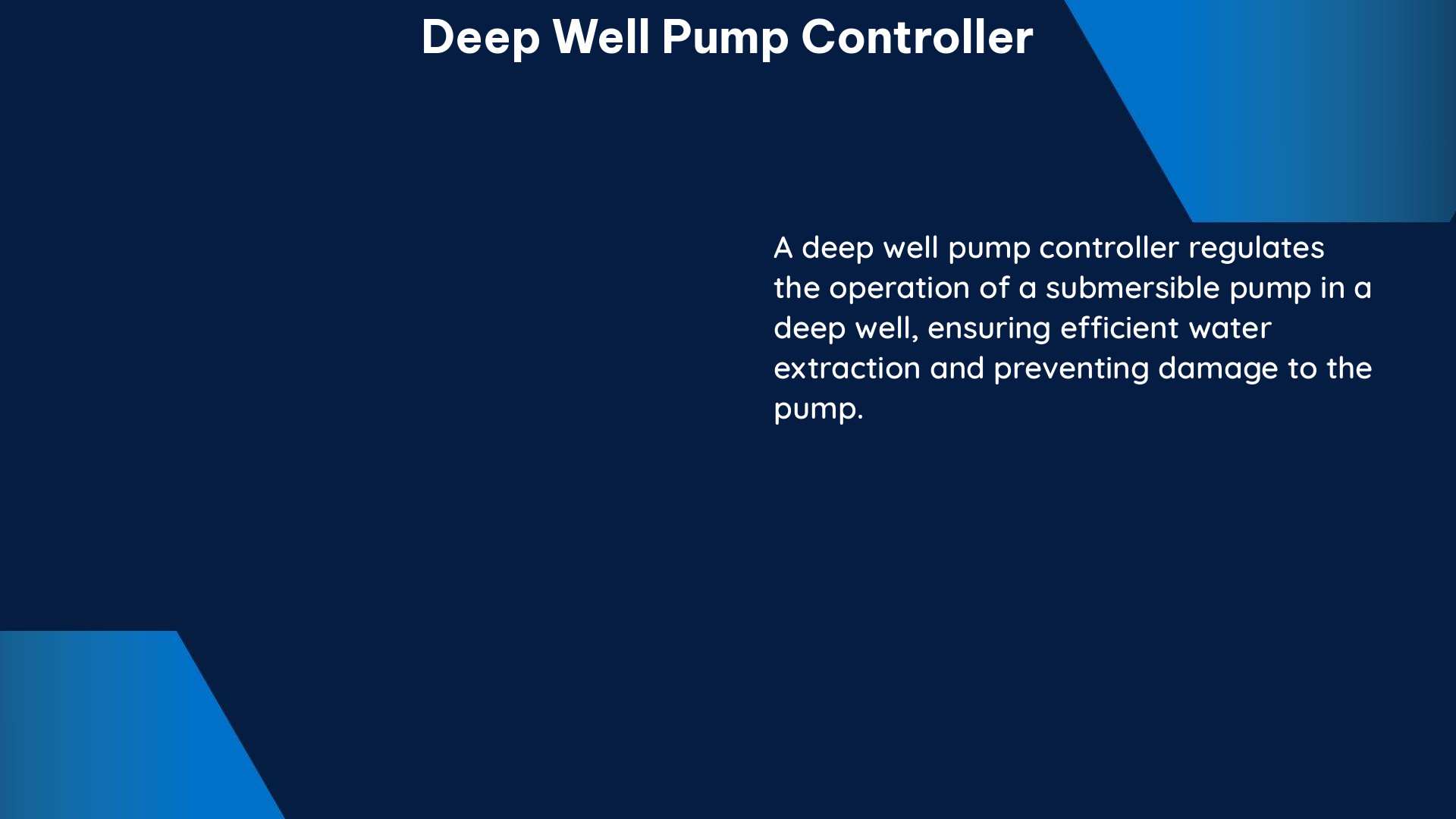A deep well pump controller is an essential component of a deep well pump system, responsible for managing and controlling the operation of the pump. The controller ensures that the pump operates efficiently, minimizing energy consumption while maintaining optimal performance. This comprehensive guide will provide you with a detailed understanding of the technical specifications, testing procedures, and advanced control strategies for deep well pump controllers.
Technical Specifications of Deep Well Pump Controller
- Voltage: 230 volts
- Horsepower: 1/2 hp
- Control Type: Submersible pump control box
- Relay Type: QD relay with 3 connections (blue, red, black)
- Continuity: Blue to red for start winding power, blue to black for run winding load
- Capacitor Test: O.L reading indicates either a bad or fully charged capacitor
- Energy Efficiency: Model-free data predictive control using deep reinforcement learning and proximal policy optimization
- Intelligent Algorithms: Analyze the operation of the well and peripheral equipment, identifying potential issues before they become critical
Relay Testing and Capacitor Evaluation

- Testing the Relay:
- Use a multimeter to check for continuity between the blue, red, and black connections.
-
The relay should provide continuity between the blue and red connections when power is applied, indicating that the start winding is being powered.
-
Testing the Capacitor:
- Use a multimeter to test the capacitor.
- An O.L reading may indicate either a bad or fully charged capacitor.
Observing Multi-Meter Readings
Carefully observe the behavior of the multi-meter reading for each component to ensure accurate testing results. This will help you identify any potential issues or anomalies in the deep well pump controller’s operation.
Implementing Intelligent Algorithms
Utilize intelligent algorithms to analyze the operation of the well and peripheral equipment, identifying potential issues before they become critical. These algorithms can be based on model-free data predictive control and deep reinforcement learning techniques.
Optimizing Energy Efficiency
Implement a data-driven methodology using model-free data predictive control and deep reinforcement learning to optimize energy efficiency in the deep well pump system. This approach involves using historical data to predict future pump performance and adjust control strategies accordingly, leading to significant energy savings.
Advanced Control Strategies
Explore the use of intelligent control systems in electric submersible pumps (ESP) to improve pump performance and longevity. A case study using an ESP pump with an intelligent control system in a well has demonstrated improved pump performance and energy efficiency compared to traditional control methods.
Conclusion
Deep well pump controllers play a crucial role in managing and controlling the operation of deep well pumps, ensuring energy efficiency, longevity, and optimal performance. By understanding the technical specifications, testing procedures, and advanced control strategies, you can effectively maintain and optimize your deep well pump system for reliable and efficient operation.
References:
- Ilushin, P.Y.; Vyatkin, K.A.; Kozlov, A.V. Development of intelligent algorithms for controlling peripheral technological equipment of the well cluster using a single control station. Bull. Tomsk. Polytech. Univ. Geo Assets Eng. 2022, 333, 59–68.
- Zyuzev, A.M.; Bubnov, M.V. Sucker-rod pumping unit balance diagnostics by wattmeter card. Bull. Tomsk. Polytech. Univ. Geo Assets Eng. 2019, 330, 178–187.
- Foss, B. Process control in conventional oil and gas fields—Challenges and opportunities. Control Eng. Pract. 2012, 20, 1058–1064.
- Zheng, X.; Shi, J.; Cao, G.; Yang, N.; Cui, M.; Jia, D.; Liu, H. Progress and prospects of oil and gas production engineering technology in China. Pet. Explor. Dev. 2022, 49, 644–659.
- Lu, H.; Guo, L.; Azimi, M.; Huang, K. Oil and Gas 4.0 era: A systematic review and outlook. Comput. Ind. 2019, 111, 68–90.
- Shigina, A.A.; Antipina, S.M.; Stupina, A.A.; Tynchenko, V.S.; Dzhioeva, N.N. Procedure of Analysis and Digital Processing of Large Data Array in Real Time upon Intellectualization of Roller Drilling. Int. J. 2020, 8, 2812–2823.
- Zahirović, I.; Danilović, D.; Martinović, B. Application of ESP pump with intelligent control system in well X. Podzemn. Rad. 2020, 37, 51–59.
- Kramarenko, V.A.; Lunev, A.S.; Kaizer, Y.F.; Tyukanov, V.L.; Lysyannikov, A.V.; Kuznetsov, A.V.; Chavyraa, C.D.; Sharshembiev, J.S. Automation of management and control system for well wellhead equipment of a production. In Journal of Physics: Conference Series; IOP Publishing: Bristol, UK, 2020; Volume 1515, p. 042085.
- Tagirova, C.; Gladkih, A.; Bakiev, D.; Vulfin, A. Modular structure of the intelligent oil production equipment control station. In Proceedings of the 2020 2nd International Conference on Control Systems, Mathematical Modeling, Automation and Energy Efficiency (SUMMA), Lipetsk, Russia, 11–13 November 2020; IEEE: New York, NY, USA, 2020; pp. 539–544.
- Chacón, E.; Besembel, I.; Hennet, J.C. Coordination and optimization in oil and gas production complexes. Comput. Ind. 2004, 53, 17–37.
- Kulaev, E.G.; Eliseev, D.B.; Vetokhin, E.G. Results of application of control stations of ESP with an intelligent system in JSC “Samotlorneftegaz”. Equip. Technol. Oil Gas Complex 2013, 6, 19–25.
- Iranzi, J.; Son, H.; Lee, Y.; Wang, J. A Nodal Analysis Based Monitoring of an Electric Submersible Pump Operation in Multiphase Flow. Appl. Sci. 2022, 12, 2825.
- Odjugo, T.; Baba, Y.; Aliyu, A.; Okereke, N.; Oloyede, L.; Onifade, O. Optimisation of Artificial Lifts Using Prosper Nodal Analysis for BARBRA-1 Well in Niger Delta. Niger. J. Technol. Dev.
- Tagirova, K.F.

The lambdageeks.com Core SME Team is a group of experienced subject matter experts from diverse scientific and technical fields including Physics, Chemistry, Technology,Electronics & Electrical Engineering, Automotive, Mechanical Engineering. Our team collaborates to create high-quality, well-researched articles on a wide range of science and technology topics for the lambdageeks.com website.
All Our Senior SME are having more than 7 Years of experience in the respective fields . They are either Working Industry Professionals or assocaited With different Universities. Refer Our Authors Page to get to know About our Core SMEs.